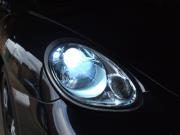Another Autoblog article reports that its readers have criticised the use of HID headlights.
 HID stands for high intensity discharge. HID (or xenon) lamps are more efficient than other types and can be made smaller. They require a high-voltage pulse to “ignite” and they run typically with an 85 volt supply, so that means a power pack – or “ballast”.
HID stands for high intensity discharge. HID (or xenon) lamps are more efficient than other types and can be made smaller. They require a high-voltage pulse to “ignite” and they run typically with an 85 volt supply, so that means a power pack – or “ballast”.
The companies who make them, and those who fit them, claim that they are more eco-friendly than halogen or tungsten bulbs. The bulbs themselves may well be – but the additional electronics will have a carbon footprint which simply doesn’t occur with the other types. I wish people would tell the whole story when they start talking eco-babble.
The only problem I have with HID bulbs is that out of the corner of your eye they frequently appear blue (they have a bluish tinge anyway, but sometimes it can be reddish depending on the angle you’re seeing them from), and I sometimes have to do a double-take to make sure it isn’t an emergency vehicle. Personally, I feel that something which takes peoples eyes off the road like that could have safety implications.
The report quotes the AA, who think that people may be getting “dangerous” mixed up with “don’t like”. After all, HIDs are most commonly fitted to high-end cars (or retro-fitted to pratmobiles). I think they’re probably right – Autoblog simply ran a survey, and these are notorious for producing opinion- instead of fact-based results. Just because people “think” something is dangerous doesn’t mean it is.
The article also deals with the issue of daytime running lights. Again, I don’t have a personal gripe, but I think the EU argument about them being safer is flawed. When only a few people drive around with their lights on (motorcyclists and cyclists) you tend to see them. When everyone rides around with them on then you just get used to lots of lights.